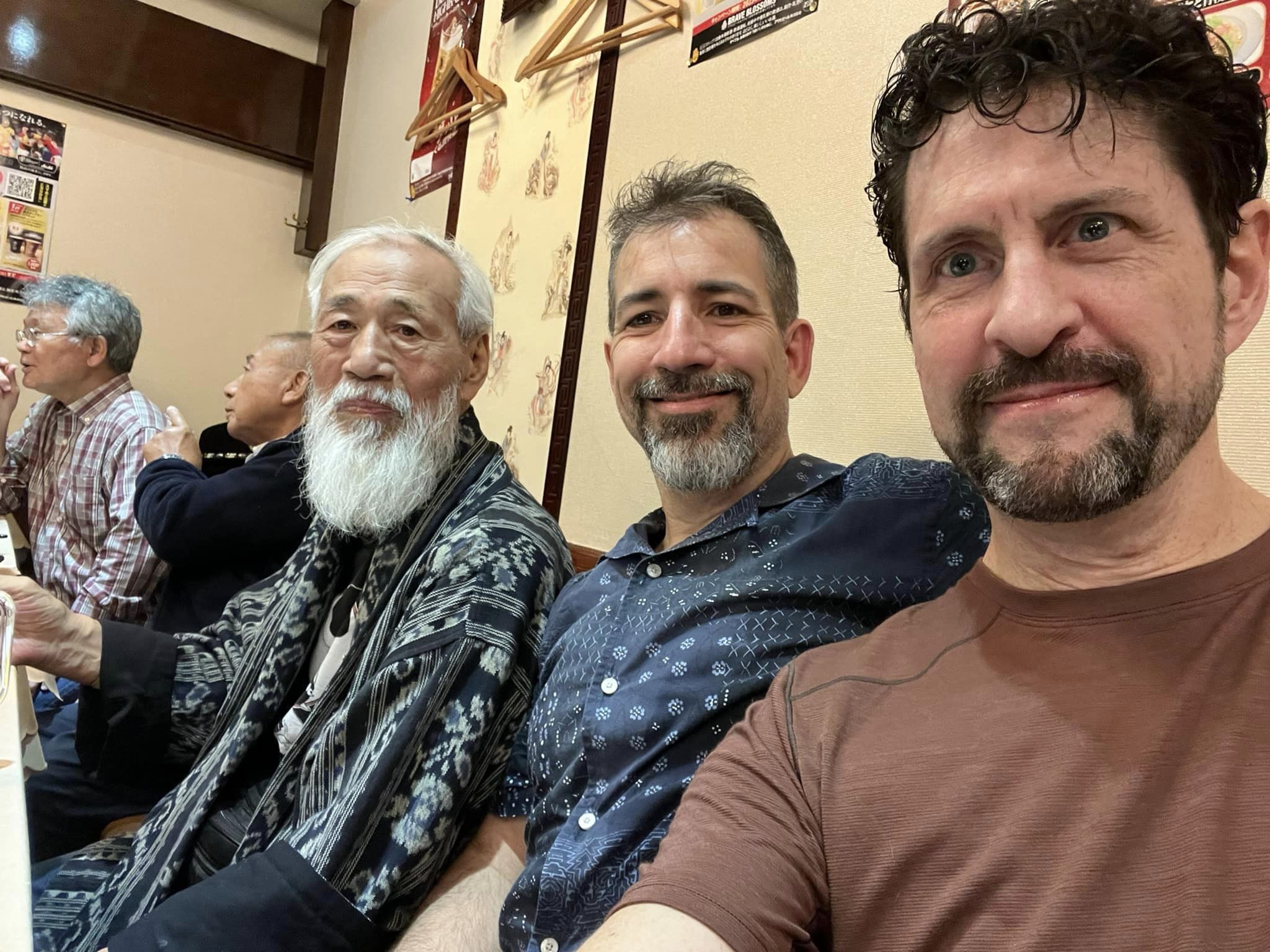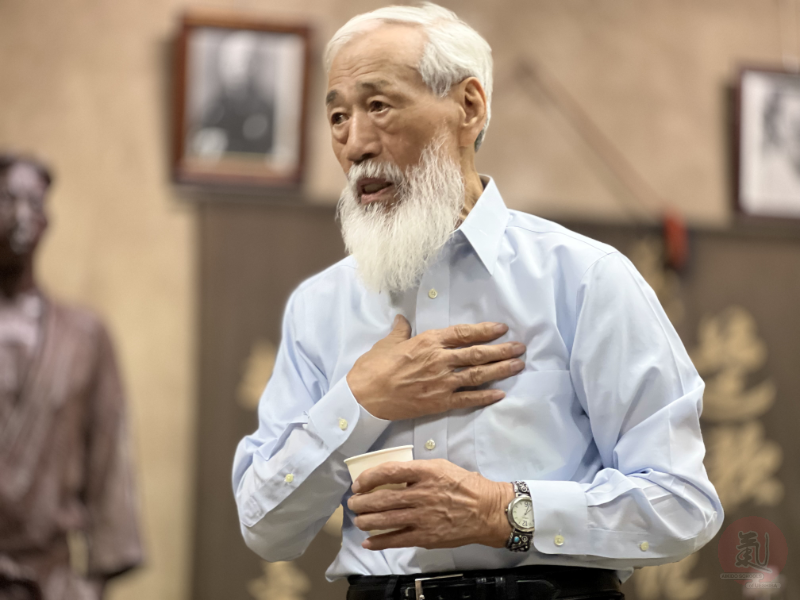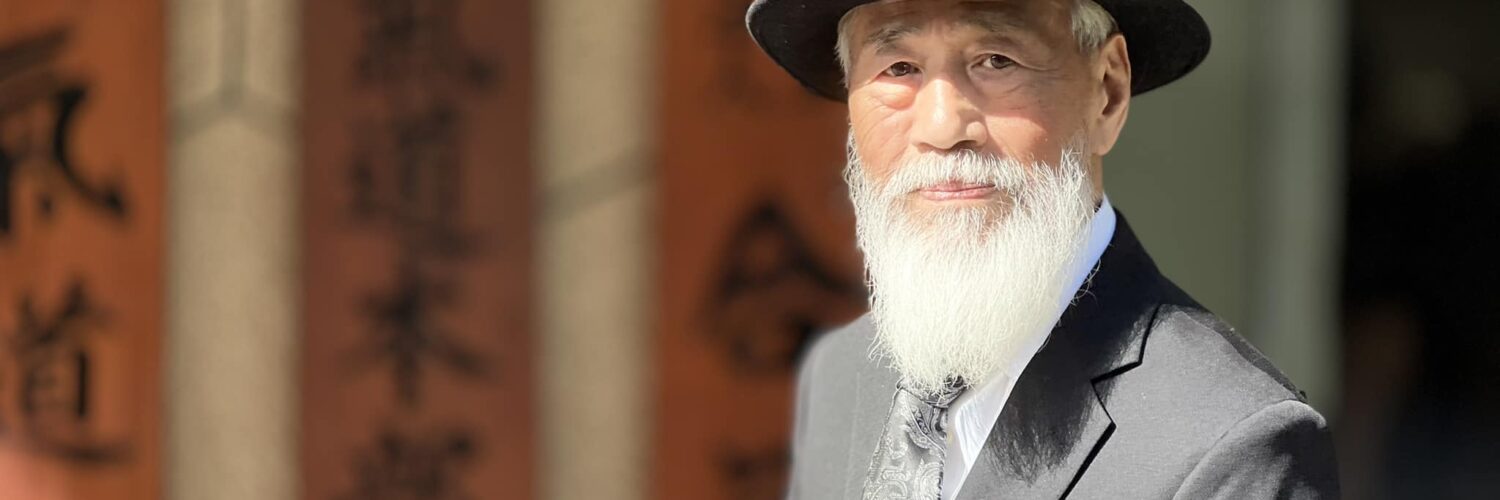The following was contributed by Guy Hagen Sensei, a student of Mitsugi Saotome Sensei and a Founder and Head Instructor of Aikido Chuseikan, in Tampa Bay, Florida.
During the first part of Saotome Sensei’s 2023 visit to Japan, several of us were staying in Tokyo in the Ueno district among a number of nearby hotels. In the mornings, before we would set out to whatever activity we had planned for the day, we would often coordinate by meeting at the Ueno train station in front of Hard Rock Cafe. This was a nice central location with great people-watching as tourists and locals bustled from exits to gates; it was an easy five minute walk from the hotels; and most importantly it was right near a Starbucks.
On about the second day of our trip, a few of us were standing about waiting for the rest to arrive. Sensei was holding his cane and Jim held a cup of coffee while sharing directions with the rest of our group by phone; Eugene was just coming back from the pastry shop; and I had just arrived and was making small talk. That that night we were scheduled to visit one of the first dojos Sensei established and I asked Sensei his thoughts about the dojos and students he left behind in Japan to come to America. He surprised me by sharing some heartfelt and articulate thoughts on “aiki” that had clearly been on his mind, and tied this back to his thoughts about student-teacher relationships.
“Guy, there are three kinds of aiki, and aiki can be good or bad quality,” he said. “The first kind is ‘body aiki’, ‘physical’; there is also ‘mind’ (he touches the center of his forehead), and ‘heart’ aiki.” I repeat back to him, “tai, shin, kokoro?” (the Japanese words for each), and he nods. If I’m being totally honest, his affirmation was not so much confirmation that I picked the right Japanese words so much as that he was glad I was paying my full attention.
He then put down his cane and grabbed my arm with both of his hands, and crudely wrestled my arm back and forth. “Bad physical aiki is just force, manipulation; it is pushing. It is bad aiki because it is not communication. Good aiki has communication, and it changes both people. A falling rock can be aiki, but it is ‘bad’ aiki because the rock is not really changed. Dancing, healing massage (he makes slow, intentful, kneading motions with his hands), a mother holding a baby: these are ‘good’ aiki because there is communication, feedback, and both are changed by the interaction. Body aiki is the blending of physical energy.”

Thinking back upon these words, I consider that perhaps that the height of “body aiki” in martial training might be experienced as the flawless technique, where through smooth timing and biofeedback one’s opponent seems to almost collaborate with the technique; for example, a jujitsu combo where all of uke’s reactions only contribute to an inevitable pin or submission.
Saotome Sensei next pointed to his temple, and then his eyes. “Second aiki is mind aiki, ‘intent’ aiki. Before the attack, Nage connects to the attacker’s being, energy. Nage moves or changes so that the attacker’s idea changes, or they cannot attack. If this is good aiki, there is communication, perception, feedback here too, but it is inside. You cannot see it if your own intent, eyes are not open and ready to change.” Sensei did not explicitly describe what bad “mind aiki” would be, but based on other conversations with him I feel an example might be instinctual “fight or flight” responses; “flight” being surrender without having an impact on the attacker, or “fight” resulting in a blind contest of intent versus intent (opposition reflex). To achieve good “mind aiki” perhaps requires compassion and perception, and willingness to be open to other outcomes.In my experience attacking Saotome Sensei, the best “mind aiki” felt like nothing at all – where I watched my body stubbornly continue to attack after Sensei already moved, or my movements short-circuited entirely as Sensei’s perfect timing and projected martial presence completely interrupted my decision to attack.
“Guy, there are three kinds of aiki, and aiki can be good or bad quality…The first kind is ‘body aiki’, ‘physical’; there is also ‘mind’…, and ‘heart’ aiki.”
Finally, Sensei tapped his chest. “Third aiki is ‘heart’ aiki, the aiki of teachers and leadership. Students are attracted to, and follow a teacher because of the teacher’s ‘essence’, the qualities they have inside. Bad heart aiki demands, or commands; it is the leader who expects to be obeyed without thought of the value of his followers, or the teacher who just wants to acquire students for their own personal ego. Students who are attracted to this type of teacher or leader will not be inspired, will not grow. However. I care about my students. My students are my true friends, my whole life.” Here, he points to me — “you, Jim, Eugene, my other deshi (disciples), my first students, all my students – every single one changed me, teaches me.” Sensei pats his heart. “For me to succeed, I must change my teaching for each of you, I must change my aikido for each of you. This way I am always growing, and I learn more about my teacher too.”














I have wonderful memories of training with Sensei back in the late 80’s and 90’s in Boulder Colorado and Bozeman MT. His presence filled the huge field house in Bozeman and the flooded the dojo in Boulder. He had the edge of a razor but deep understanding and wisdom as well!
Those days long gone but still as though yesterday.
Thanks for the wonderful piece on Sensei 🙏
Although this article is short, Saotome Sensei captures the three types of Aiki in a short and concise way. I would like to expand upon his third type of Aiki – heart aiki – “My students are my true friends, my whole life.” Here, he points to me — “you, Jim, Eugene, my other deshi (disciples), my first students, all my students – every single one changed me, teaches me.” Sensei pats his heart. ” To expand Saotome Sensei’s thought I leave you with a quote from Hikitsuchi Sensei:
If you change your heart your behaviour will change
If you change your behaviour then your habits will change
If you change your habits then your character will change
if you change your character then your destiny will change.”
Merci pour cet article si profond. J’ai eu la joie de participer à un stage avec Senseï à Nantes dans les années 90. Quelle évolution lorsque je regarde ses dernières vidéos. J’ai presque 70 ans et continue de m’entraîner seul ou avec mon fils. L’aïkido a beaucoup changé, en bien? J’ai eu le bonheur de pratiquer avec 6 ou 7 des élèves majeurs japonais d’ O’senseï ainsi que Maître Nocquet qui avait un profond respect envers son Maître
What a profound and beautiful exposition on aiki! I am struck by the concept of good aiki being the capacity to change, to respond, physically, mentally, and in the heart. What a statement that Saotome Shihan makes about learning from his students! This is something I’ve heard many teachers talk about. As an educator, I recognize this as a special quality of excellent teachers, regardless of what they are teaching! They don’t just provide information, they learn with their students and they learn from their students about becoming better teachers, and better people.